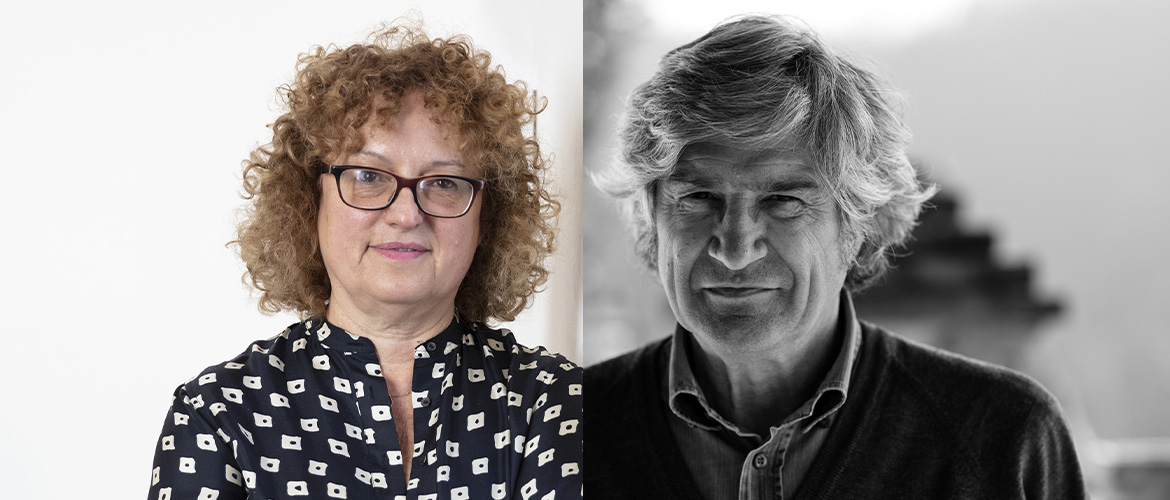Carolyn Christov-Bakargiev, curator of the Arte Povera exhibition at the Bourse de Commerce and an internationally-recognized specialist in Arte Povera, talks to Giuseppe Penone, a major figure in this artistic movement and studio director at the Beaux-Arts de Paris between 1997 and 2012, about the artist's seminal gestures and the genesis of the exhibition.
Giuseppe Penone is one of the most important sculptors of the generation of artists that critics traditionally associate with the Arte Povera movement, when he produced his first works in the late 1960s, working directly on trees in the forests of the Alpes Maritimes.
What sets him apart is his constant reference to natural elements and the primary gesture of touch. In his works, it is the interaction between the artist's action and that of nature that gives form to a material that is different each time (wood, clay, marble, bronze), revealing its intrinsic mystery. And following the principle of similarity that exists in nature, the artist discovers the anatomy of marble veins and experiments with the “vegetal” quality of bronze in his large-scale outdoor tree installations.
Giuseppe Penone has exhibited in many countries, from Germany to the United States and Japan, and his work can be found in the collections of major museums. Since 2000, the Jardin des Tuileries has been home to his Arbre des voyelles, while his Jardin des sculptures fluides at Venaria Reale Castle, near Turin, was inaugurated in 2007. Representing Italy at the 2007 Venice Biennale, he was invited in 2012 to take part in dOCUMENTA (13) (Kassel), then to the gardens of Versailles and Madison Square Park in New York (2013), which became the setting for his bronze trees and stone Ideas. In his latest exhibitions, his sculptures enter into an unprecedented dialogue with masterpieces from the Uffizi Galleries (2021) and the Borghese Gallery in Rome (2023).
Giuseppe Penone has been a foreign associate member (sculpture section) of the Académie des Beaux-Arts de Paris since 2022.
Carolyn Christov-Bakargiev (b. 1957, lives and works in Turin, Rome, and New York) is a world-renowned art historian, curator, and museum director. After graduating magna cum laude from the University of Pisa in 1981, she began researching Arte Povera and meeting its artists. This research led to her first major essay on the movement in Flash Art magazine in November-December 1987, marking the 20th anniversary of Germano Celant’s key essay in the same publication, and in 1999 to the publication of her widely read book Arte Povera (Phaidon Press) which includes in depth surveys and research on all the key artists of the movement, Giovanni Anselmo, Alighiero Boetti, Pier Paolo Calzolari, Luciano Fabro, Jannis Kounellis, Mario Merz, Marisa Merz, Giulio Paolini, Pino Pascali, Giuseppe Penone, Michelangelo Pistoletto, Emilio Prini, Gilberto Zorio.
She served as a curator for Antwerp Cultural Capital of Europe (1993) and for Villa Medici, Rome (1998-2000), before moving to New York as Chief Curator at MoMA/P.S.1 (1999-2001). In 2002, she returned to Italy as Chief Curator of Castello di Rivoli Museo d'Arte Contemporanea. In 2008, she curated the 16th Biennale of Sydney, where she first exhibited Giuseppe Penone's Idee di Pietra in a park in front of the Art Gallery of New South Wales. In late 2008, she was appointed Artistic Director of dOCUMENTA (13) in Kassel, which took place in 2012. In 2009, she also served as interim Director of Castello di Rivoli, while preparing dOCUMENTA(13). This exhibition expanded beyond Kassel to Banff, Canada; Alexandria, Egypt; and Kabul, Afghanistan, and also included Penone's Idee di Pietra in Kassel’s Auepark. She directed the 14th Istanbul Biennial in 2015, featuring the work of Giovanni Anselmo. In 2016, she returned to Castello di Rivoli as Director, a position she held until late 2023.
Since 2021, she has been an Honorary Guest Professor at the FHNW University of Applied Sciences and Arts Northwestern Switzerland and is currently a freelance curator and writer. Christov-Bakargiev’s early career was deeply influenced by her encounters with Arte Povera, and she introduced the topic of multi-species co-evolution into the field of contemporary art through her dOCUMENTA (13) exhibition and research from 2009-2012. She has championed a vision of the interconnectedness of art, science, philosophy, and technology, as well as the healing potentials in art. She is currently researching artistic freedom, embodiment, and transcendence in aesthetics in the digital era, and exploring the continued relevance of Arte Povera from a global perspective.
Her major exhibition on Arte Povera for Collection Pinault is currently on view until 20 January 2025. This exhibition features Penone’s Idee di Pietra, which belongs to Pinault Collection, in front of La Bourse itself and a gallery of works by the artist. It examines Arte Povera not only as a significant movement of Italian artists using humble materials and simple techniques in the 1960s and early 1970s but also as part of a long history of art focused on the phenomenological reduction of experience, channelling energy and life as constant embodied presences. This state of mind and form of art-making has roots in Mediterranean notions of metamorphosis and alchemy and continues to inspire artists worldwide today.
Photo credits: Carolyn Christov-Bakargiev © Courtesy of Castello di Rivoli Museo d'Arte Contemporanea (Rivoli-Turin), photo Sebastiano Pellion and Giuseppe Penone © Archivio Penone




